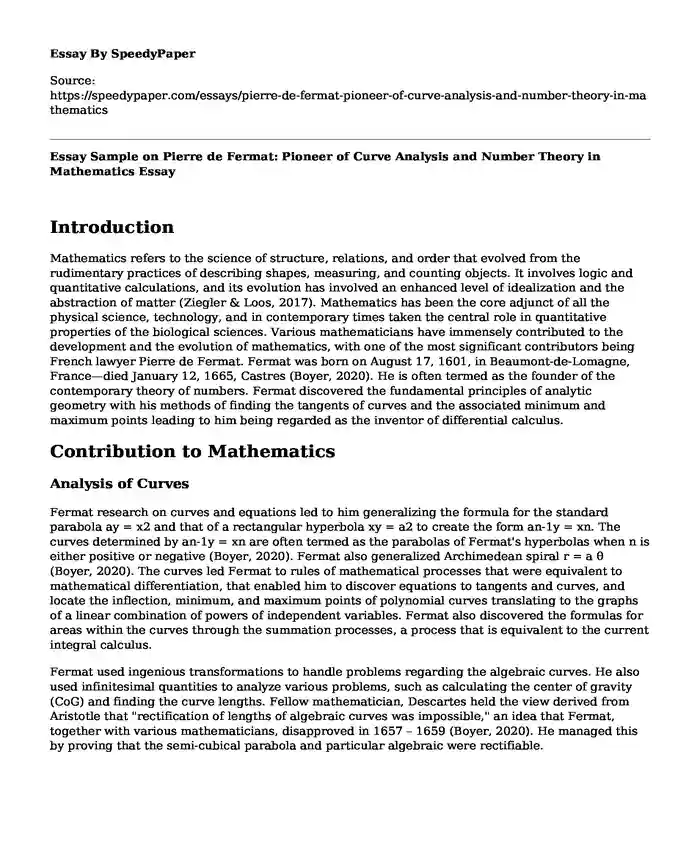
| Type of paper: | Essay |
| Categories: | Analysis Mathematics |
| Pages: | 3 |
| Wordcount: | 685 words |
Introduction
Mathematics refers to the science of structure, relations, and order that evolved from the rudimentary practices of describing shapes, measuring, and counting objects. It involves logic and quantitative calculations, and its evolution has involved an enhanced level of idealization and the abstraction of matter (Ziegler & Loos, 2017). Mathematics has been the core adjunct of all the physical science, technology, and in contemporary times taken the central role in quantitative properties of the biological sciences. Various mathematicians have immensely contributed to the development and the evolution of mathematics, with one of the most significant contributors being French lawyer Pierre de Fermat. Fermat was born on August 17, 1601, in Beaumont-de-Lomagne, France—died January 12, 1665, Castres (Boyer, 2020). He is often termed as the founder of the contemporary theory of numbers. Fermat discovered the fundamental principles of analytic geometry with his methods of finding the tangents of curves and the associated minimum and maximum points leading to him being regarded as the inventor of differential calculus.
Contribution to Mathematics
Analysis of Curves
Fermat research on curves and equations led to him generalizing the formula for the standard parabola ay = x2 and that of a rectangular hyperbola xy = a2 to create the form an-1y = xn. The curves determined by an-1y = xn are often termed as the parabolas of Fermat's hyperbolas when n is either positive or negative (Boyer, 2020). Fermat also generalized Archimedean spiral r = a θ (Boyer, 2020). The curves led Fermat to rules of mathematical processes that were equivalent to mathematical differentiation, that enabled him to discover equations to tangents and curves, and locate the inflection, minimum, and maximum points of polynomial curves translating to the graphs of a linear combination of powers of independent variables. Fermat also discovered the formulas for areas within the curves through the summation processes, a process that is equivalent to the current integral calculus.
Fermat used ingenious transformations to handle problems regarding the algebraic curves. He also used infinitesimal quantities to analyze various problems, such as calculating the center of gravity (CoG) and finding the curve lengths. Fellow mathematician, Descartes held the view derived from Aristotle that "rectification of lengths of algebraic curves was impossible," an idea that Fermat, together with various mathematicians, disapproved in 1657 – 1659 (Boyer, 2020). He managed this by proving that the semi-cubical parabola and particular algebraic were rectifiable.
Theory of Numbers
Using the inspiration from a 1621 edition, Arithmetic of Diophantus, Fermat discovered new results in the then called higher arithmetic, most of which related to the elements of prime numbers – the numbers that lack factors besides one and themselves, for example, three. The most elegant of the discovery was the theorem that each prime number of the form 4n + 1 is individually expressible as a sum of the two squares (Boyer, 2020). A more significant outcome currently known as Fermat lesser theorem indicates that if a specific number p is a prime number, and if a number a is an integer, then a p – a is divisible by p (Boyer, 2020). His results were reinforced further by the case proofs provided by Gottfried Leibniz, a mathematician, and philosopher, together with Leonhard Euler, who was an 18th-century Swiss mathematician. Fermat often used a method termed as infinite descent, which is an inverted form of logic by recurrence or mathematical reduction.
Conclusion
Mathematics is the most dynamic and interesting subject of all time. Either consciously or subconsciously, individuals are always calculating, measuring, and comparing outcomes using a stream of numbers to make logical conclusions. However, mathematics evolved from the basic calculations to complex analysis, which impacts significantly on physical sciences. This was been enabled by great contributors such as Pierre de Fermat, who discovered the formula for curve analysis and developed numbers theory.
References
Ziegler, G. M., & Loos, A. (2017). "What is Mathematics?" and why we should ask, where one should experience and learn that and how to teach it. Proceedings of the 13th International Congress on Mathematical Education, 63–77. https://doi.org/10.1007/978-3-319-62597-3_5
Boyer, B., B. (2020, August 13) Pierre de Fermat | Biography & Facts. (, 2019). In Encyclopædia Britannica. https://www.britannica.com/biography/Pierre-de-Fermat
Cite this page
Essay Sample on Pierre de Fermat: Pioneer of Curve Analysis and Number Theory in Mathematics. (2023, Dec 16). Retrieved from https://speedypaper.net/essays/pierre-de-fermat-pioneer-of-curve-analysis-and-number-theory-in-mathematics
Request Removal
If you are the original author of this essay and no longer wish to have it published on the SpeedyPaper website, please click below to request its removal:
- Free Essay Sample on Vaccination - Microbiology Discussion
- Essay Sample: Introduction to Hypothesis Testing
- Essay Sample on New Conservatism: Republican Shift from 1960s-1980s
- Supreme Court of Canada Extends Protection to Collective Bargaining & Strikes - Essay Sample
- Data Coding: The Organizational Process of Sorting & Synthesizing Data - Essay Sample
- Paper on Cloud Computing Unveiled: A Comprehensive Analysis and Implementation Guide for BallotOnline
- American Political Disputes - Essay Sample
Popular categories




